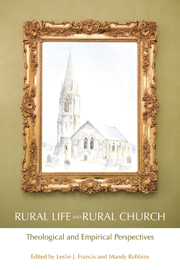Book contents
- Frontmatter
- Contents
- Preface
- Foreword by The Bishop of Shrewsbury, The Rt Revd Mark Rylands
- 1 Introduction: shaping rural theology
- PART 1 PERSPECTIVES FROM THE BIBLE
- PART 2 PERSPECTIVES FROM ORDINARY THEOLOGY
- PART 3 THEOLOGICAL AND SOCIOLOGICAL PERSPECTIVES
- PART 4 HISTORICAL PERSPECTIVES
- PART 5 LISTENING TO VISITORS
- PART 6 LISTENING TO THE COMMUNITY
- 18 Social capital generated by two rural churches: the role of individual believers
- 19 Local festivals in two Pennine vill ages: the reactions of the local Methodist church congregations
- 20 Extended communion: a second best option for rural Anglicanism?
- PART 7 LISTENING TO CHURCHGOERS
- PART 8 LISTENING TO CHURCH LEADERS
- PART 9 SATISFACTION AND STRESS IN MINISTRY
- Contributors
- Sources
- Subject Index
- Name Index
19 - Local festivals in two Pennine vill ages: the reactions of the local Methodist church congregations
from PART 6 - LISTENING TO THE COMMUNITY
- Frontmatter
- Contents
- Preface
- Foreword by The Bishop of Shrewsbury, The Rt Revd Mark Rylands
- 1 Introduction: shaping rural theology
- PART 1 PERSPECTIVES FROM THE BIBLE
- PART 2 PERSPECTIVES FROM ORDINARY THEOLOGY
- PART 3 THEOLOGICAL AND SOCIOLOGICAL PERSPECTIVES
- PART 4 HISTORICAL PERSPECTIVES
- PART 5 LISTENING TO VISITORS
- PART 6 LISTENING TO THE COMMUNITY
- 18 Social capital generated by two rural churches: the role of individual believers
- 19 Local festivals in two Pennine vill ages: the reactions of the local Methodist church congregations
- 20 Extended communion: a second best option for rural Anglicanism?
- PART 7 LISTENING TO CHURCHGOERS
- PART 8 LISTENING TO CHURCH LEADERS
- PART 9 SATISFACTION AND STRESS IN MINISTRY
- Contributors
- Sources
- Subject Index
- Name Index
Summary
Abstract – National and local festivals, carnivals and processions are a feature of social life and the way in which the human race has celebrated in its leisure moments. This article examines the reaction of two local Pennine village churches to a festival in each of their communities. It highlights certain features of the relationship between village festivals and the life of the local church.
Introduction
Festivals, carnivals and the gathering of people for local celebrations are part of social life. People come together in large groups to follow some interest, or to mark some local or national achievement, and have done so since early times. It is through such occasions that the stresses of ordinary life can be put aside, and enjoyment found in social pursuits with others. The Bible witnesses to the fact that religion has often been the initiator of such celebrations. Examples can be found throughout the Old Testament of how Israel came together on great days to celebrate both national and religious events. The story of how David brought the Ark of the Covenant to Jerusalem, told in 1 Chronicles 15, is one example of how such happenings were integral to the religious and political life of the people of Israel. The ritual significance of such events is apparent. Psalm 24 is another example, where the repetitive question and answer in the text suggests that it is a part of a liturgy associated with some great political or religious event in the life of the people of Israel. One can imagine the procession approaching the closed city gates and the ritual question and answer as the gates are opened and the procession moves into the city for the climax of the event.
- Type
- Chapter
- Information
- Rural Life and Rural ChurchTheological and Empirical Perspectives, pp. 229 - 241Publisher: Acumen PublishingPrint publication year: 2012



